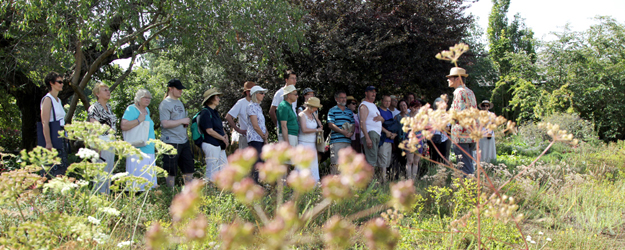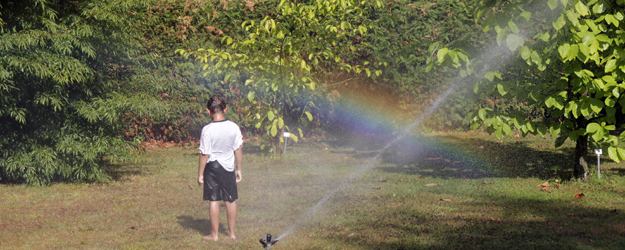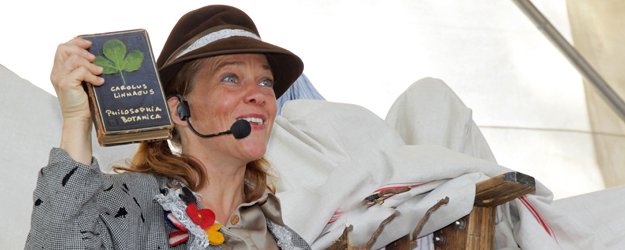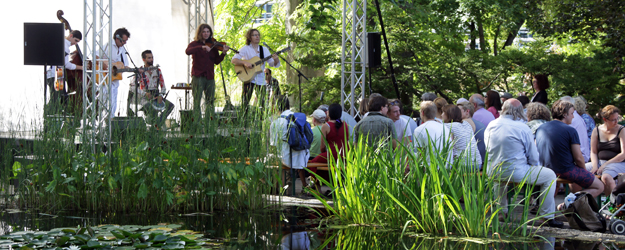27 August 2012
On the hottest day of the year, the Botanic Garden of Johannes Gutenberg University Mainz (JGU) held its summer festival. Thousands came to inspect the grounds, attend concerts and the children's theater, meander between couscous and bratwurst, or rush to the popular plant bazaar.
Sunday 11:00 a.m.: Hordes of people crowd behind the red and white tape, their gaze fixed anxiously on the long rows of tables covered in green. The row of tables they have their eyes is full of greenery. Large baskets and boxes stand ready for the booty "This place brings out basic instincts," comments a visitor at the back of the crowd. But why is he standing back? "My wife is in charge today. She's waiting at the front – I will be merely acting as a beast of burden."
Then the tape comes down and the rush to the tables begins. A dozen helpers try to keep things organized. Tree oleander and red hazel, Kashmir bergenia and spice oleander, figs and cacti change hands in seconds. Long lines form in front of both of the cash registers.
1,200 plants on offer
As is already tradition, the plant bazaar kicks off this year's summer festival in JGU's Botanic Garden. "We have been coming for three years," says the waiting man. "The quality here is better than in the stores. But we also come because of the special atmosphere."
Roughly 1,200 plants are on offer. "We finance a large part of the festival with proceeds from the sale of the plants," says Dr. Ralf Omlor, custodian of the Botanic Garden. His colleagues have themselves grown the green produce. Some are the result of trainees practicing propagation while others are simply superfluous plants.
It is the hottest day of the year but the stream of visitors does not let up. While some bring their treasures to safety, the next wave attacks all the other things on offer. A simple lawn sprinkler becomes a special attraction in the sweltering heat. The youngest visitors jump around squealing under the fountain of cool water while small rainbows form above it all.
A steppe in the Botanic Garden
In the meantime, Omlor begins the series of tours of the Botanic Garden. The "Mainz Sand Dunes and steppe plants" are his topic. "Many of our visitors are aghast: 'Dear God, what is going on here? Isn't anybody taking care of this place?' they ask." It is indeed true that the various steppe landscapes differ in appearance from the carefully ordered plant beds near them. "We've been able to recreate the steppe quite well here," explains Omlor with a hint of pride.
Steppes like it dry and warm. "Mainz has the lowest annual rate of precipitation in Germany. We get about 500 millimeters a year. Steppes need 400 to 450 millimeters. So we're almost there."
It is because of this that the Mainz Sand Dunes between Mombach and Gonsenheim, a natural part of the ancient steppe landscape, has survived near Mainz. And it is this that is reproduced in the Botanic Garden. Here, the sand taken from the Mainz nature conservation area typically extends to depths of up to one meter. This means that the water from rainfall rapidly drains off, preventing the plants rotting.
Mainz: a biodiversity hot spot
"The natural vegetation we see around us now gradually returned only 10,000 years ago after the last ice age. Bit by bit, the steppe landscape disappeared," explains Omlor. However, some survived near Mainz, making the region into a hot spot for biodiversity. There are rare plants, such as the purple goldendrop (Onosma arenaria) that can be found in Germany only in the Mainz Sand Dunes region and in the Botanic Garden.
Omlor rips out a tiny tree that is little more than a seedling. "This shouldn't be here. We need to weed intensively, so that nothing out of place grows. It's a real challenge for our gardeners. They not only need to know the 40 to 50 plants that are supposed to grow here, but also the 400 to 500 that need to be weeded out."
Gardening- and botany-inspired puppet theater
2:00 p.m.: The festival is firing on all cylinders, the plant bazaar shuts down. All its produce has been sold. The Jens Mackenthun Trio exits the stage. Their relaxing jazz is replaced by the Artisjok Theater of Anke Scholl. The play, Flora Primelwurz, has botany- and gardening-related themes and is designed for younger visitors. The puppet actor conjures a fantastic, exciting world from a simple handcart.
The festival has in general a lot to offer for children. There is a special circuit with six stations where they can find out more about the Botanic Garden. They can also weave flower wreaths, discover herbal scents, or plant their own mimosas in pots that they have made themselves from newspaper.
Because of the weather, however, one attraction seems to be taking center stage: "Hey Dad," says one little squirt, "I've found something." "What is it?" "A real lawn sprinkler."
60 sweaty assistants
At around 5:00 p.m., the festival begins to wind down. The around 60 helpers, members of the Friends of the Botanic Garden and employees of the Green School and the Garden, are sweaty but happy. Thousands came to buy plants, to try freshly tapped beer, couscous, and bratwurst, or to find out about more about nature. And for the finale, there is a highly danceable mix of tango and blues, klezmer and Indian sounds.
The Absinto Orkestra is given enthusiastic applause and sends the visitors home with a composition of its own: "The streets are deserted / And the sun is scarcely seen. / We've almost forgotten / How different it could have been. / It's hard to wave goodbye with your hands in your pocket. / So pack up your things and follow summer like a rocket."
Oh well, maybe the text wasn't exactly suitable for the summer festival and the hottest day of the year, but otherwise everything else was perfect.




